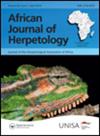Analysis of genetic diversity in Rose’s mountain toadlet (Capensibufo rosei) using novel microsatellite markers
IF 0.9
4区 生物学
Q3 ZOOLOGY
引用次数: 5
Abstract
Abstract On the Cape Peninsula, Capensibufo rosei is known from only two isolated breeding populations within Table Mountain National Park. Because of its declining state, there is an urgent need to understand the genetic diversity, population structure and patterns of movement of this species. To do this, 15 microsatellite primer pairs were designed, optimised and tested. Successful loci were screened for null alleles and genotyping errors and then analysed, specifically noting the number of alleles, allelic size range, observed and expected heterozygosities, deviations from Hardy–Weinberg equilibrium (HWE) and linkage disequilibria. Bottleneck tests and analyses of molecular variance (AMOVA) were also conducted to gain insight into each population’s structure. Eleven primer pairs produced unambiguous polymerase chain reactions (PCR) products and scoreable bands, which were found to be polymorphic across both breeding populations. Deviations from HWE were detected owing to the presence of null alleles and inbreeding. Significant bottleneck signatures were detected for both populations and the AMOVA revealed significant differentiation between the two populations, indicating genetic structure at the population level.利用新型微卫星标记分析玫瑰山蟾蜍的遗传多样性
在开普半岛,桌山国家公园内只有两个孤立的繁殖种群。由于其濒危状态,迫切需要了解其遗传多样性、种群结构和迁徙模式。为此,对15对微卫星引物进行了设计、优化和测试。筛选成功基因座的零等位基因和基因分型错误,然后进行分析,特别注意等位基因的数量、等位基因大小范围、观察到的和预期的杂合度、偏离Hardy-Weinberg平衡(HWE)和连锁不平衡。瓶颈测试和分子方差分析(AMOVA)也进行了深入了解每个群体的结构。11对引物产生了明确的聚合酶链反应(PCR)产物和可评分的条带,这些条带在两个育种群体中都是多态性的。由于存在零等位基因和近交,检测到与HWE的偏差。在两个种群中均检测到显著的瓶颈特征,AMOVA显示两个种群之间存在显著的分化,表明在种群水平上存在遗传结构。
本文章由计算机程序翻译,如有差异,请以英文原文为准。
求助全文
约1分钟内获得全文
求助全文
来源期刊

African Journal of Herpetology
ZOOLOGY-
CiteScore
3.00
自引率
6.70%
发文量
15
审稿时长
>12 weeks
期刊介绍:
African Journal of Herpetology (AJH) serves as an outlet for original research on the biology of African amphibians and reptiles. AJH is an interdisciplinary journal that publishes original articles and reviews from diverse fields and disciplines, such as conservation, phylogenetics, evolution, systematics, performance, physiology, ecology, behavioural ecology, ethology, and morphology.
The Journal publishes two issues a year. There are no page charges .
 求助内容:
求助内容: 应助结果提醒方式:
应助结果提醒方式:


